
The Ups and Downs of the Expansion Valve
November 23, 2021 | By Dave Demma
While there are multiple methods of accomplishing heat transfer, the most common uses the vapour compression cycle.
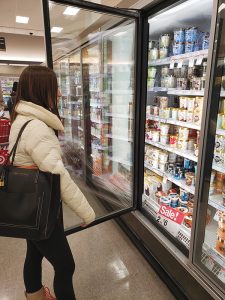 Refrigeration is a heat transfer process. By removing heat from the space to be conditioned, whether it’s a display case in a supermarket or an office space in a commercial building, the result is a reduction in temperature.
Refrigeration is a heat transfer process. By removing heat from the space to be conditioned, whether it’s a display case in a supermarket or an office space in a commercial building, the result is a reduction in temperature.
While there are multiple methods of accomplishing heat transfer, the most common uses the vapour compression cycle in which the goal is to provide refrigerant at a state/condition that makes it usable as a heat transfer fluid.
I’ve mentioned this before but it bears repeating: there are four major components used in the vapour compression cycle: the compressor, the condenser, an expansion device and the evaporator. In this article I will focus on the role of the expansion device, specifically considering the thermal expansion valve (TEV or TXV) or electronic expansion valve (EEV).
Vapour Compression Cycle Review
In brief, here are the roles of the four major components:
The compressor receives the relatively cool low pressure vapour and converts it into a high pressure vapour. A byproduct of the compressor process is the addition of heat to the vapour, resulting in a superheated vapour.
The condenser receives the superheated vapour from the compressor where the vapour goes through the following process: (1) desuperheating, bringing the vapour to a saturated condition; (2) change of state, with the vapour transforming into a liquid; and (3) further heat transfer, resulting in some amount of subcooling—end result is a warm high pressure liquid.
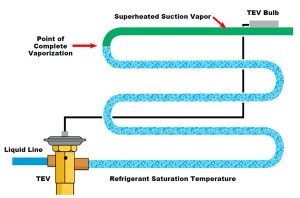
Figure 1 – TEV in System.
The warm high pressure liquid flows through the expansion device’s small port, resulting in a reduction in pressure. When a saturated liquid refrigerant experiences a reduction in pressure, it must also undergo a reduction in temperature and assume the new saturation temperature for that pressure. This is accomplished as a percentage of the liquid refrigerant flowing through the port flashes into a vapour, removing heat from the remaining liquid refrigerant in the process, achieving the temperature reduction. The refrigerant leaves the expansion device as a mixture of saturated liquid and vapour, and at a cooler temperature. The TEV/EEV regulates the refrigerant mass flow entering the evaporator by responding to the superheat at the outlet of the evaporator. As the superheat increases/decreases in relation to the superheat set-point, the valve will throttle close/open in an effort to maintain the set-point.

Figure 2: TEV operation with display case door closed.
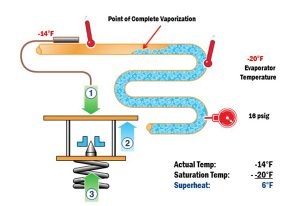
Finally, the cold saturated liquid-vapour mixture enters the evaporator inlet, and flows through tubing. Fans circulate air in the conditioned space through the evaporator’s fin-tube bundle, allowing the heat in the air to be transferred to the cold saturated refrigerant flowing through the evaporator tubing. This heat transfer process results in the saturated liquid changing state into a vapour. At some point, near the end of the evaporator tubing, the last molecule of saturated liquid boils into a vapour (point of complete vaporization). The remaining portion of the evaporator tubing allows heat to continue to be transferred to the refrigerant vapor, resulting in a superheated vapour.(see Figure 1)

Figure 3: shopper opens door, changing the refrigeration load inside the display case.
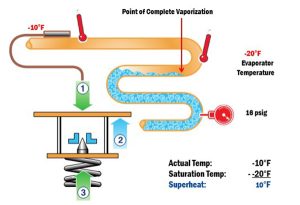
Expansion Devices
There are several types of expansion devices, with some of them being a fixed orifice (such as a cap tube, or flow rater). While they are less expensive and do not require any adjustment, they do not have the ability to modulate as the heat load and/or system conditions change.
The advantage of the TEV and EEV in comparison to fixed orifice expansion devices include: they do have the ability to respond to changes in the heat load and system conditions. This ability to modulate maintains the proper refrigerant mass flow entering the evaporator under all conditions. As the refrigeration load increases/decreases, the TEV/EEV will open/close in an effort to maintain its superheat set-point. This maintains the correct refrigerant mass flow to the evaporator inlet and maintains the proper superheat at the evaporator outlet, which protects the compressor by preventing liquid floodback.
Most applications are subject to wide refrigeration load variations, commercial building doors opening, heat transmission through walls and windows, walk-in box door openings and many more…there is no such thing as a constant refrigeration load.
While variations in the refrigeration load may be small or large, a refrigeration load that is constantly varying results in a TEV/EEV that is constantly in a state of repositioning itself to meet the new load demand.
When rapid and significant changes to the refrigeration load occur, the previously adequate TEV opening (stroke) becomes completely inadequate.
TEV Capacity
The TEV capacity can be best described as the refrigeration effect (heat transfer capacity of the refrigerant at the condition the system is operating at, in Btu/lb) multiplied by the liquid refrigerant mass flow (in lb/min) delivered by the TEV to the evaporator inlet. The heat load being transferred to the saturated liquid refrigerant in the evaporator constitutes the greatest portion of the refrigeration effect. This causes the refrigerant to undergo a change of state; a latent heat transfer process.
It is essential for the TEV/EEV to have 100% liquid (no vapour) at the valve’s inlet to operate at its rated capacity. Otherwise, it can not deliver the necessary refrigerant mass flow to meet the demand of the heat load.
Opening and Closing
While the TEV/EEV regulates the refrigerant mass flow entering the evaporator, it responds to changes in superheat at the evaporator outlet to determine when the valve opens/closes.
For example: Picture your local supermarket’s lineup of ice cream display cases (with glass doors). The doors are normally closed until product needs to be loaded, or a customer selects some merchandise to be purchased. For example, Figure 2 (page 56) shows a shopper arriving at the display case, but the glass door has not been opened. The load is relatively constant. There would be a slight amount of heat transmitting through the glass and framework, but not a lot. The TEV is feeding the -20F saturated liquid-vapour refrigerant mixture into the evaporator, absorbing heat from the air in the space, with the liquid changing state into a vapour. A small portion of the evaporator is being fed by 100% vapour, allowing the vapour to experience a sensible heat gain, resulting in a vapour temperature of -14F and allowing the TEV to maintain its superheat set-point of 6F.
Figure 3 shows the shopper opening the door. The warmer ambient air entering the space would cause a rapid increase to the refrigeration load inside the display case. Ideally, the increased heat load would trigger a simultaneous increase in TEV opening (stroke), resulting in the necessary increase in refrigerant mass flow to meet the demand of the new heat load.
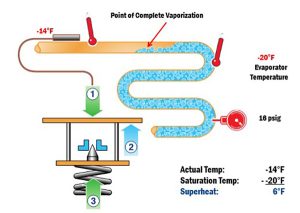
Figure 4: system reaching equilibrium with door remaining open.
In reality, there is a time lag between an increase in the heat load and the resulting change in TEV stroke due to the fact that the TEV cannot directly sense changes in the refrigeration load, but only the result of a change in refrigeration load, and that result is the superheat setting at the evaporator outlet.
The process is as follows: with the door opening, additional heat enters the refrigerated space and is transferred to the saturated refrigerant in the evaporator. The refrigerant then boils at a quicker rate, resulting in a higher superheat condition at the evaporator outlet. The increased superheat then causes the TEV to open, supplying more refrigerant to the evaporator in an effort to reduce the superheat back to the TEV set-point.
After some amount of time, as the door remains open, the system will reach an equilibrium. The increase in refrigerant mass flow will counteract the increase in refrigeration load, and the superheat will once again reach its set-point (as shown above in Figure 4).
At some point the shopper selects the merchandise and closes the door. Once again there is a change in refrigeration load. And, once again the TEV is playing “catch up”.
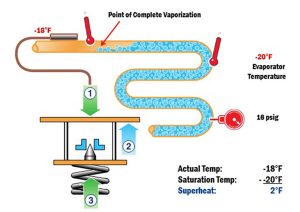
Figure 5: after shopper closes door.
In Figure 5, with the door closing, and the refrigeration load reduction, the TEV is now open too much. The liquid refrigerant will now boil at a slower rate, with the point of complete vaporization moving closer to the evaporator outlet. This results in a lower superheat setting…in this case, 2F superheat. The sensing bulb senses this, and causes the TEV to throttle closed, reducing the refrigerant mass flow in an attempt to reach the superheat set-point.
As the shopper moves to another location in the store, and the refrigeration load becomes somewhat stable again. After some amount of time, with the door closed, the system will once again reach an equilibrium. With the superheat back at its set-point and life is good again—at least until the next shopper arrives.
This is a representation of what the typical TEV/EEV goes through all day long. The refrigeration load is never constant. The system conditions which influence TEV/EEV capacity are never constant. As such, the life of a TEV/EEV is one that is in constant turmoil, attempting to maintain the superheat set-point in an ever-changing world.
Finally, while this should be given a more in-depth discussion at a later date, suffice it to say that a motorized valve (EEV) with an electronic controller has a much better ability to precisely and repeatedly control superheat as compared to a mechanical TEV. <>

 Dave Demma holds a degree in refrigeration engineering and worked as a journeyman refrigeration technician before moving into the manufacturing sector where he regularly trains contractor and engineering groups. He can be reached at
Dave Demma holds a degree in refrigeration engineering and worked as a journeyman refrigeration technician before moving into the manufacturing sector where he regularly trains contractor and engineering groups. He can be reached at 


